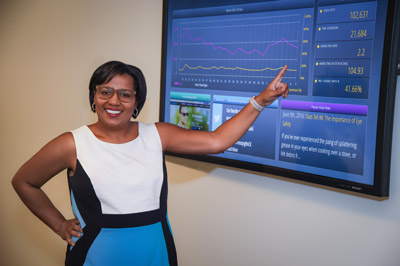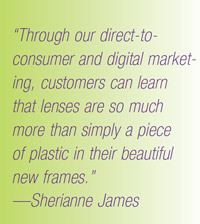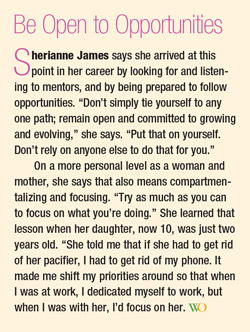

Sherianne James, vice president of consumer brands at Essilor, came to her role in marketing via the unconventional route of chemical engineering. Soon after her graduation from the University of Florida, she was recruited by Kraft Foods to work in the company’s R&D area. “Kraft is known for its consumer-focused marketing, so even in R&D, I quickly developed a consumer-centric persona,” she says. James moved into the company’s marketing division, and a later move to Florida brought her to Transitions Optical and, ultimately, to Essilor. “I was looking for a company with a major brand, as well as a passion and commitment to put the customer at the center of its business.”
At Essilor, eyecare professionals (ECPs) are the company’s most important customers. “We make sure we develop products
with a strong understanding of what patients need so we can help ECPs build their practices by driving traffic and helping them service their patients better.” For example, many consumers think of new eyeglasses only in terms of the frame because that’s the component they can choose. “Through our direct-to-consumer and digital marketing, customers can learn that lenses are so much more than simply a piece of plastic in their beautiful new frames.” These marketing efforts are helping patients engage in more thorough conversations with their ECPs. “We are building awareness that eye health is just as important as other health concerns, and we’re educating consumers on how Essilor products address and solve these concerns.”


Options for progressive lenses and those that protect against Harmful Blue Light are other examples of areas that consumers often know little about. “One of the challenges for us is that a lot of the needs in eye care are latent. In contrast, if you are marketing
beauty products, your consumer is aware of his or her problem and knows there is a product to solve it. But patients may not realize there are solutions and accept their suboptimal visual experiences. For example, if they experience symptoms like tired eyes from using their digital devices, they just accept this because they aren’t aware of the lenses with the Smart Blue Filter™ feature.”
That means that Essilor must be as innovative in its marketing outreach as it is in its R&D. “It requires the same discipline. Both are about continuing to evolve and improve in terms of product development and also in the best way to elevate the consumers’ experience,” James says.
This reality makes marketing much more complex than it was when she first entered the field. “For example, social media has had a huge impact on marketing, giving ‘word of mouth’ a whole new meaning. We need to understand this and see how consumers are
engaging with it.”


It’s not an easy task, especially with the greater complexity of the Essilor product portfolio. Essilor’s marketing messages are designed to help educate both patients and ECPs. “Most patients see the doctor as the primary and most trusted source of information. It’s our job to create well-informed patients and empower ECPs to reinforce those messages,” she says. But it’s not simply a matter of pushing the advertising in front of consumers. “We do still want to create compelling marketing for all of our brands, for example, but we also want to capture consumers’ attention where they are looking. So if someone searches ‘nighttime driving,’ that person will hit on a description of no-glare lenses. If someone searches ‘blue light,’ that person would land on information about Eyezen™ or Eyezen+™ lenses. We want patients to come in to their ECP’s office not just asking for one of the Essilor products, but asking about all of them
that might be relevant.”
James says the trajectory of consumers’ path to knowledge and discovery about new products is exciting to her. “By analyzing what websites and terms are being searched, we’re able to find people, learn what they’re doing and what solutions we can present.”
It makes her career at Essilor an ideal fit, she says. “Essilor has a passion and commitment for its brands, and I’ve discovered a wealth of opportunities to add value by helping connect consumers to solutions for better sight.”
1 Through in vitro experimentation on swine retinal cells, Essilor and the Paris Vision Institute identified the wavelengths of visible light believed most toxic to retinal cells, which fall between 415nm and 455nm on the light spectrum and peaking at 435nm (blue-violet light).



